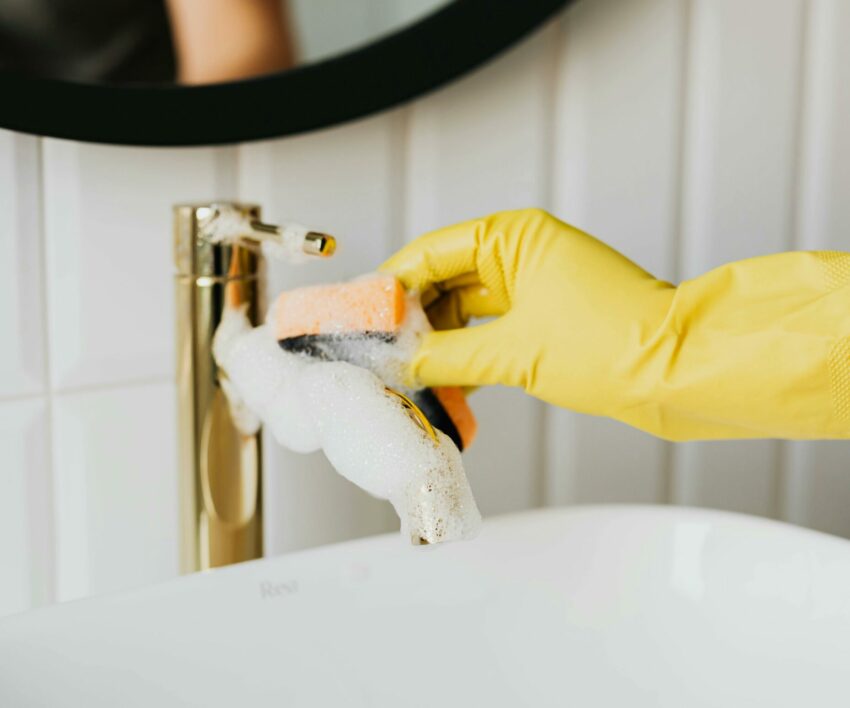
person cleaning a faucet: picture: pexels
Chrome fixtures add a sleek, sophisticated touch to any home. Whether it’s in the bathroom, kitchen, or even your garden, chrome can elevate the look of your space with its timeless shine. However, this beautiful material is also notorious for showing smudges, fingerprints, and watermarks.
The good news? With a few simple tools and techniques, keeping your chrome sparkling is easier than you might think. Here’s a step-by-step guide to help you clean your chrome surfaces effectively.
Tools you’ll need:
- Dish soap
- White vinegar
- Chrome polish
- Microfiber cloth
- Non-scratch sponge
How to clean chrome with dish soap
Dish soap is an effective and readily available cleaner for chrome surfaces. Here’s a simple method to restore your chrome’s shine:
- Add a few drops of dish soap to a non-scratch sponge.
- Run the sponge under water to create suds.
- Gently scrub the chrome surface using circular motions.
- Rinse the area thoroughly with water.
- Dry with a microfiber cloth to prevent water spots.
For an extra shine, you can apply chrome polish using a clean, dry microfiber cloth after cleaning.
How to clean chrome with vinegar
Vinegar is an affordable, natural solution for tackling tough water spots and mineral deposits on chrome fixtures. Here’s how to use it:
- Mix equal parts white vinegar and water in a small bowl.
- Dip a microfiber cloth into the mixture and gently rub it onto the chrome surface.
- Allow the vinegar to sit for a few minutes to break down any mineral deposits.
- Rinse the surface thoroughly with water.
- Buff the chrome with a dry microfiber cloth to bring back the shine.
If you’d like, you can also use chrome polish afterwards for a high-gloss finish.
How to remove rust from chrome
Rust can be a common issue on chrome fixtures, especially in humid environments. Removing rust requires a bit more effort and a speciality product like Chemico All-Purpose Cleaning Paste, which contains oxalic acid. This chemical reacts with the rust, making it easier to remove. Here’s the process:
- Sprinkle some of the powdered cleanser onto a sponge.
- Gently scrub the rusted areas, making sure to scrub with the grain of the chrome to avoid scratches.
- Wipe away any residue with a damp cloth.
- Dry the area with a microfiber towel.
Avoid using water directly with the cleaner, as it can dilute its effectiveness. For best results, go slowly and repeat the process as needed.
How often should you clean chrome?
The key to maintaining the beauty of chrome is regular cleaning. In high-traffic areas like bathrooms and kitchens, aim to clean chrome fixtures one to three times a week. If you want to prevent fingerprints and smudges, a quick daily wipe with a microfiber cloth will go a long way.
Additional tips for sparkling chrome
- Limescale buildup: If your chrome has limescale buildup, soak paper towels in vinegar and wrap them around the affected areas. Leave them on until they dry, then rinse and repeat as needed.
- Prevent water marks: Installing a water softener in your home can help reduce hard water stains and spots on chrome.
- Avoid abrasive materials: Always use non-scratch sponges and avoid any harsh, acidic cleaners that could stain or damage your chrome surfaces.
- Dry after cleaning: Make it a habit to dry your chrome immediately after washing to prevent water spots.
With the right cleaning routine, your chrome fixtures will maintain their shine and keep on adding sophistication to your home for years to come.
Compiled by: Jade McGee
First published by Woman&home
Also see: Spring cleaning your bedroom for a better night’s sleep
